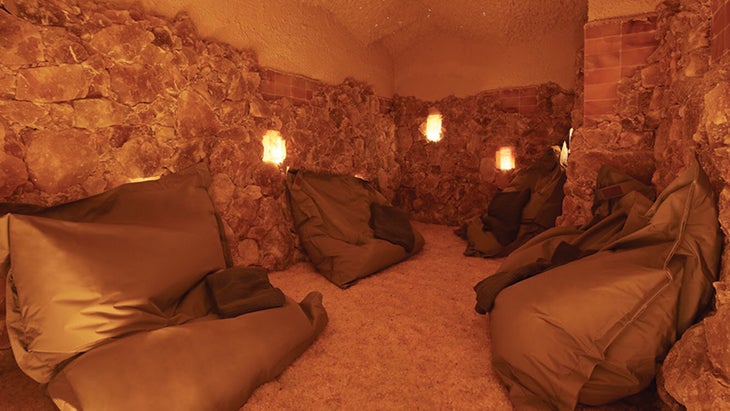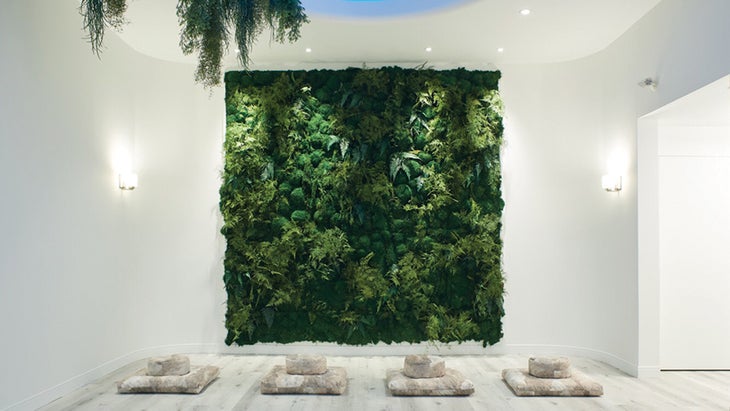“], “filter”: { “nextExceptions”: “img, blockquote, div”, “nextContainsExceptions”: “img, blockquote, a.btn, a.o-button”} }”>
Google “how to meditate,” and the simplest set of instructions looks like this: Find a quiet place to sit. Set a timer for 10 to 15 minutes. Focus on your breath. Notice when your mind wanders and drop the thought when it does. Easy enough, right?
Perhaps, like me, you’ve tried to follow these simple directions, only to experience a steady stream of inane thoughts: What am I eating for lunch? What am I doing this weekend? I’m coming back to my breath. I’m listening to my breath. I’m so good at meditating. Nope, back to square one.
Central to the traditional Buddhist philosophy, meditation is meant to encourage appreciation of the present moment, the acknowledgment of the mind’s inner chatter and to teach the practitioner to act more mindfully. Benefits abound from regular meditation including better focus, diminished anxiety, reduced memory loss and a longer life span. Everyone from celebs to entrepreneurs are singing its praises, from Arianna Huffington to Katy Perry, and today, meditation is being taught in schools, hospitals and even prisons.
Knowing that the benefits are so profound, I set out to make meditation part of my daily routine for two weeks. But having tried and failed at regular meditation in the past, I knew I would need some tools, teachers and maybe even some technology to help me succeed. I tested out a variety of styles as well, including mantra, breathwork and mindfulness practices to see what suited me best. Here’s what I learned along the way.
Start with a class
Motivating myself to get started was my biggest hurdle. Unsure what time of day best suited me, for how long, where to sit (on the floor, outside, on a pillow), these insignificant issues weighed on me before I started.
I signed up to several studios offering a variety of styles (including breathwork, mindfulness, mantras and visualization), allowing someone else to guide me through the process from beginning to end. With some guideposts, I learned techniques I could fall back on when I later practiced on my own. The novelty of attending each class was something to look forward to, and locking in the appointments on my calendar made the commitment a set part of that day. Having a teacher also took some of the onus off me: The instructor led us through the exercise, at times guiding and reminding the class in a calm voice that everything is transient and to name and release thoughts as they inevitably arise. After about five minutes, I found myself focused on my breath and pulling my awareness back to it easily, as opposed to the times I had tried it out on my own.
Add some technology
For most of us, attending a meditation studio every night isn’t realistic (whether it be a matter of cost or time), but apps and gadgets can help when trying to establish this habit. I downloaded the Headspace app, practiced with it for 10 minutes twice a day and found the simple guided meditations a useful aid. The app acted as a teacher substitute, starting each session with a new idea or metaphor to focus the mind while I practiced.
MindSet Brain Gym, one of the studios I attended, includes a device called the Muse 2 as a part of their sessions. It’s an EEG neurofeedback transmitter that uses sensors to measure brain waves. This tool was created to aid in the meditation process providing audio cues to indicate when the mind is busy and when it has become calm. When the mind becomes active, the device responds with the audio of an intense storm. When the mind has quieted, the sounds of the storm disappear. Once I got over my intimidation of being assessed by a glorified headband, I was thrilled by the real-time feedback, working to calm and clear my mind and have the audio reflect. The scan (at left) indicated that what I was doing was creating an impact in a place
I couldn’t see. It was like working out a muscle but never knowing whether that muscle was toned or not.
Helpful tools to add to your routine
Add these to your routine to achieve peace with ease.
- Essential Oil Province Apothecary Black Spruce + Fir Balsam Essential Oil Incense $16, provinceapothecary.com
- The app Headspace $13/month, headspace.com
- EEG Neurofeedback Device Muse 2, $249, choosemuse.com

Create your own peaceful space
With light and dark meditation rooms, a salt cave, a signature fragrance called Blend 430 (with top notes of bergamot and grapefruit chosen for their stress-relieving qualities) and green juice shots before and after our session, Hoame studio removed any residual discomfort I had associated with meditation. Inspired, I began to make a little nook and created a ritual for my personal practice at home—turning on an essential oil diffuser, lighting unscented candles, turning off lights, putting my phone on silent and making myself a cup of chamomile tea. This became the precursor and in some way a part of the meditation itself, as I started slowing down and getting into the contemplative frame of mind.
Encouraged by the co-founders of Hoame, I also took my meditative practice away from the bolster and into everyday moments after my 30-minute session. They suggested I find stillness and presence in the mundane, whether that meant slowly sipping a cup of coffee in order to taste it, listening to the sounds of my commute instead of being plugged into a podcast or feeling the air around me on my morning jog instead of rushing through it. The purpose is to experience my senses fully rather than zoning out. I like the practicality of this, remembering that the goal of meditation is not to become a better meditator but to become more focused, peaceful and better able to navigate the crazy world.
Unexpected benefits
- Sleep: I hate to brag, but I’ve traditionally been a great sleeper. Recently, I began waking up two or three times in the night, certain it was morning. While I was in bed for the full 8 hours, I knew my quality was lacking. Once I started meditating before bed, I began sleeping deeply once more – no interruptions.
- Focus: As the self-appointed (and only) millennial in the Clean Eating editorial office, I filled the stereotype of being addicted to my phone. Some of my fellow editors can’t understand my penchant for posting Instagram stories. While I enjoy being connected to the social world around me, I had a gnawing desire to constantly check in, even when I had turned my device onto airplane or silent mode. Being unable to finish reading an article without the tug of a push notification or the bing of a message felt slavish. After my journey into meditative bliss, I’m ditching my phone more and more, no regrets and no itch or twitch.
- Cravings curbed: Cutting back on mindless eating has been a goal of mine since I started at Clean Eating. We’re pretty lucky to have a seemingly endless supply of tasty (and healthy) snacks at the office, but everything in moderation, even good-for-you snacks. Recognizing those true hunger pangs, rather than feeding my stress, anxiety, boredom, happiness and every other emotion, has been one more unintended but welcome perk of adding a bit of silence to my day.

Find a studio in your city
With the sudden popularity of meditation, it might be difficult for newbies to differentiate centers that are simply hype from those striving for a higher purpose. Steph Kersta, co-founder of Hoame Studio in Toronto, Canada, shares a few tips on how to find the right studio for you.
- Consider the credentials of the teachers and owners. Look for spaces that have experienced and certified teachers with years of experience.
- Search out diverse and welcoming spaces. Studios should be inclusive to all ages and genders and be physically accessible. Look for centers that build community or give back, two central tenets of the practice of dana (or generosity).
- Safety first. Meditation can bring up intense emotions, therefore the approach should always be toward safety, and teachers should build trust.
Mantras & more
During my 14-day challenge, I pushed myself out of my comfort zone, experimenting with a range of styles. Simple and easy to get into, mantra meditation was my favorite. All that was required was the repetition of a single word or phrase to focus the mind. Visualization meditation was fun, but I often found myself getting distracted. I tried a “loving kindness” exercise, in which you imagine sending love to individuals in your life, but conjuring friends and family sent me into a spiral of conversations and obligations. Breathwork meditations challenged me the most; I felt silly trying to get the correct technique and this distracted me from calming my thoughts. Mindfulness meditation ended up being my default. It was widely practiced at the studios and focuses on releasing thoughts as they arise by focusing on the natural rhythm of the breath.

